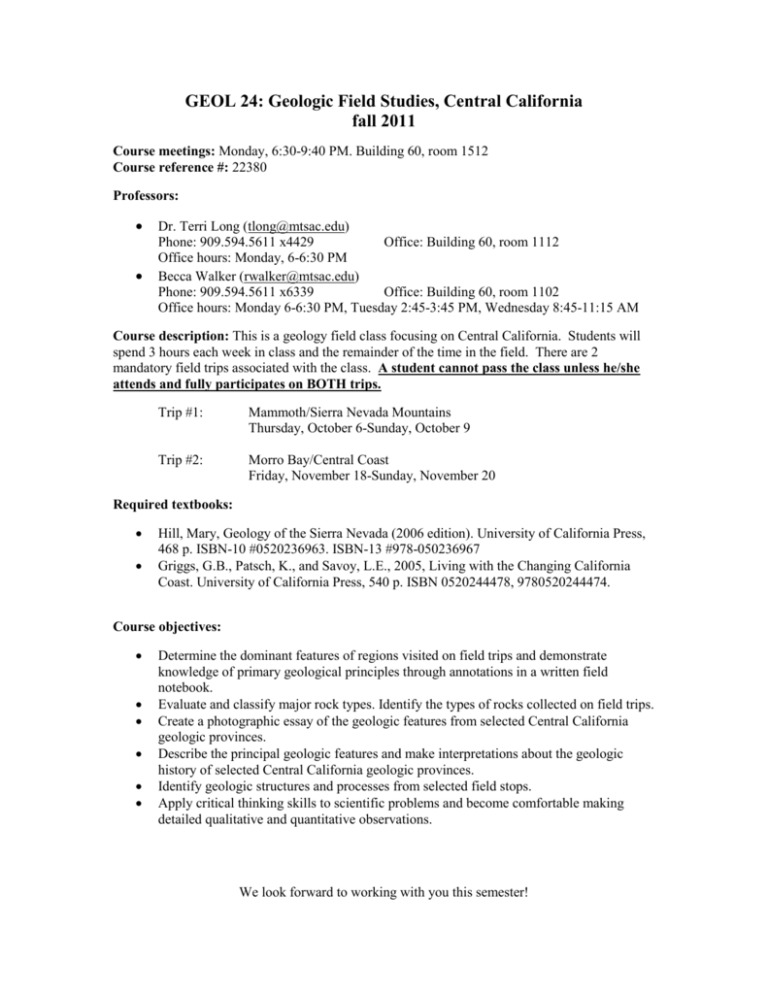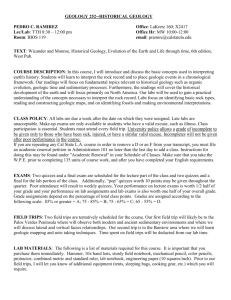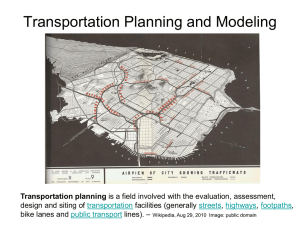syllabus for field studies of Central California
advertisement

GEOL 24: Geologic Field Studies, Central California fall 2011 Course meetings: Monday, 6:30-9:40 PM. Building 60, room 1512 Course reference #: 22380 Professors: Dr. Terri Long (tlong@mtsac.edu) Phone: 909.594.5611 x4429 Office: Building 60, room 1112 Office hours: Monday, 6-6:30 PM Becca Walker (rwalker@mtsac.edu) Phone: 909.594.5611 x6339 Office: Building 60, room 1102 Office hours: Monday 6-6:30 PM, Tuesday 2:45-3:45 PM, Wednesday 8:45-11:15 AM Course description: This is a geology field class focusing on Central California. Students will spend 3 hours each week in class and the remainder of the time in the field. There are 2 mandatory field trips associated with the class. A student cannot pass the class unless he/she attends and fully participates on BOTH trips. Trip #1: Mammoth/Sierra Nevada Mountains Thursday, October 6-Sunday, October 9 Trip #2: Morro Bay/Central Coast Friday, November 18-Sunday, November 20 Required textbooks: Hill, Mary, Geology of the Sierra Nevada (2006 edition). University of California Press, 468 p. ISBN-10 #0520236963. ISBN-13 #978-050236967 Griggs, G.B., Patsch, K., and Savoy, L.E., 2005, Living with the Changing California Coast. University of California Press, 540 p. ISBN 0520244478, 9780520244474. Course objectives: Determine the dominant features of regions visited on field trips and demonstrate knowledge of primary geological principles through annotations in a written field notebook. Evaluate and classify major rock types. Identify the types of rocks collected on field trips. Create a photographic essay of the geologic features from selected Central California geologic provinces. Describe the principal geologic features and make interpretations about the geologic history of selected Central California geologic provinces. Identify geologic structures and processes from selected field stops. Apply critical thinking skills to scientific problems and become comfortable making detailed qualitative and quantitative observations. We look forward to working with you this semester! Course policies and personal conduct 1. Attendance and punctuality: It is essential that you come to class, arrive on time, and stay for the entire class meeting. If you have more than 3 unexcused absences prior to November 4th, you will be dropped from the class. After November 5th, your final grade in the class will be lowered by one letter grade if you accrue more than 3 unexcused absences. Two tardies will be counted as one absence. Students who habitually arrive late or leave early will have their final grade lowered by a full letter grade. During the first two weeks of class, any student arriving late, leaving after the break, or missing class will automatically be dropped. The last day to drop the class with a “W” is November 4th. 2. Makeups: Exams, field trips, field projects, and labs cannot be made up under any circumstances. 3. Late work: NO LATE WORK IS ACCEPTED. ALL LATE WORK RECEIVES A ZERO. Please don’t ask us to accept late work from you. The only possible exception to this policy is if you have a medical emergency for which you can provide written documentation. If you are going to be absent from class on the day that an assignment is due, you must hand your assignment in before the due date. 4. Academic honesty: Cheating is a major offense that we take very seriously. If the professor determines that a student has cheated, the student will receive a failing grade in the course. Additional disciplinary action may be taken in the form of probation, suspension or expulsion, per the administrative procedures on student discipline. Some examples of academic dishonesty: Copying one or more answers from someone else’s exam. Using cheat sheets, crib notes, etc. during an exam. Using information from a book, magazine, website, etc. without citing its source. If you have any other questions about what constitutes academic dishonesty, plagiarism, cheating, copying, etc., please ask. 5. Cell phone/electronic device etiquette: Your phone must be turned OFF (not on vibrate or silence) and put AWAY (not visible) while you are in the classroom. Students whose beepers, cell phones, etc., disturb class will be charged 10 points. Students are not allowed to use cell phones or listen to musical devices in the field. Musical devices with headphones can be used at campsites and in the vehicles. 6. Field trip substance policy: Students may not bring any weapons, alcohol, cigarettes, or drugs on the field trips. These items are strictly prohibited by College policy. Course grades You have the potential to earn 1000 points this semester. Exams: 30% of final grade Exams #1, #2, and Final 300 points Field trip portfolio: 25% of final grade Field notebook: 30% of final grade Lab exercises: 10% of final grade Quizzes: 5% of final grade 250 points 300 points 100 points 50 points Total: 1000 points Each student’s final grade will be calculated based on the total number of points that he/she earns: A (excellent): 895-1000 points (equivalent to 89.5%-100%) B (very good): 795-894 points (equivalent to 79.5-89.4%) C (average): 695-794 points D (unsatisfactory): 595-694 points F (failing): below 595 points Exams: Exams will consist of multiple choice, true/false, short answer, essay, and identification questions. The exams will cover required reading material, lecture material and information discussed on the field trips. Field trip portfolio: You will prepare a portfolio for each field trip which will include a photo journal and rock/mineral sample boards. In the photo journal, each photograph must include location name and labeled geologic features. Photo journals should not be larger than 8 ½ x 11”. You will collect rock and mineral samples on each field trip. Rocks and minerals must be glued to an 8 ½ x 11” board. The samples must be identified and include the location from which the sample was collected. All labels in the photo journal and on the sample boards must be typed. Field notebook: You are responsible for keeping detailed field notes during both field trips, which you will submit after each trip. Detailed instructions on field notes will be provided later in the semester. Lab exercises: There will be several lab exercises done during class meetings related to the geology of Central California. Quizzes: Weekly quizzes will be administered at the beginning of class meetings. These quizzes will cover materials discussed in the previous week’s lecture, as well as the textbook reading for that day. Extra credit opportunities: There will be 60 points of extra credit offered. 1) 2) Bonus questions on exams 1 and 2 Oral presentation up to 20 points up to 40 points Tentative schedule for GEOL 24, fall 2011 Week Date Lecture topic 1 Aug 29 2 3 Sept 5 Sept 12 Introductions, syllabus Plate tectonics No class: campus closed Earthquakes and faults 4 Sept 19 5 Sept 26 6 Oct 3 Oct 6-9 7 Oct 10 8 Oct 17 9 Oct 24 10 Oct 31 11 Nov 7 12 13 Nov 14 Nov 18-20 Nov 21 14 Nov 28 15 Dec 5 16 Dec 12 Volcanic and orogenic processes in the Eastern Sierras and Long Valley Caldera Sierra Nevada glaciations Map interpretation and field trip preparation Required field trip to Eastern Sierras (Thursday-Sunday) Review of field stops, assembly of field materials Exam #1 FIELD TRIP MATERIALS DUE Sedimentary processes in coastal environments Tectonic history of the Central California Coast Coastal features and processes Productivity and the intertidal zone Required field trip to Morro Bay (Friday-Sunday) Review of field stops, assembly of field materials Exam #2 FIELD TRIP MATERIALS DUE Presentations Review for final exam Final exam, 7:30-10:00 PM Lab topic Mineral identification Igneous rocks Metamorphic rocks Field geology Topographic maps Sedimentary rocks Relative age dating Waves and currents Marine taxonomy Reading due for today





